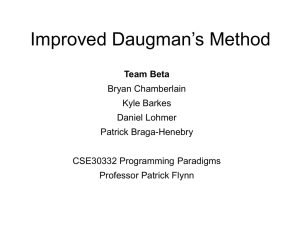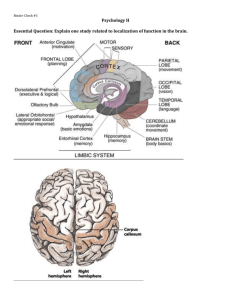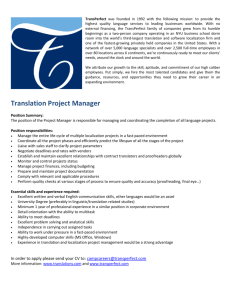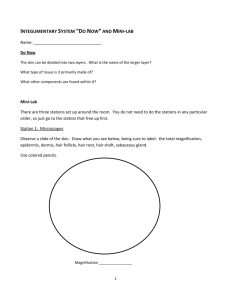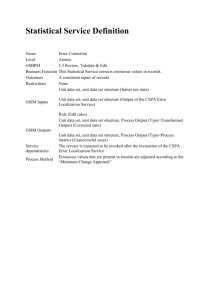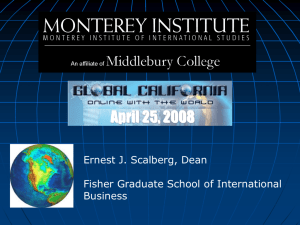Presentation
advertisement
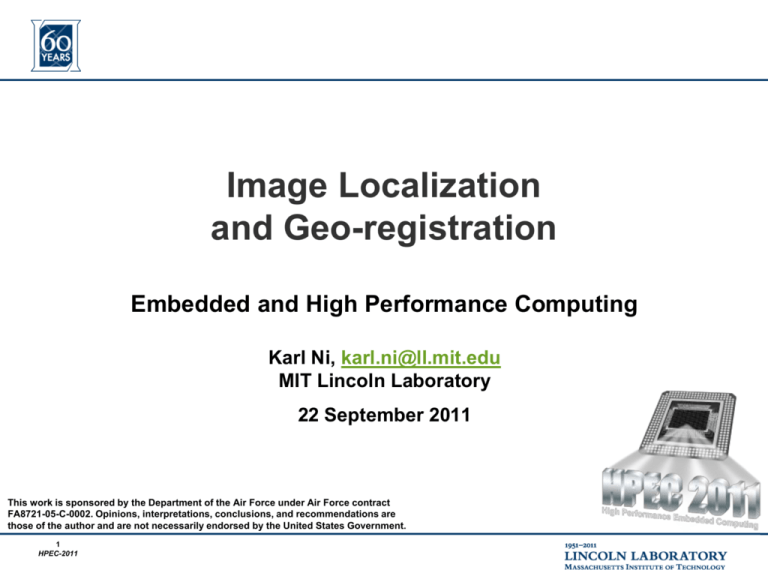
Image Localization and Geo-registration Embedded and High Performance Computing Karl Ni, karl.ni@ll.mit.edu MIT Lincoln Laboratory 22 September 2011 This work is sponsored by the Department of the Air Force under Air Force contract FA8721-05-C-0002. Opinions, interpretations, conclusions, and recommendations are those of the author and are not necessarily endorsed by the United States Government. 1 HPEC-2011 Acknowledgements • Embedded and High Performance Computing (G102) – – – – Karl Ni Katherine Bouman Scott Sawyer Nadya Bliss • Active Optical Systems (G106) – Alexandru Vasile – Luke Skelly – Peter Cho • Cornell University – Noah Snavely 2 HPEC-2011 PED Vision DoD/IC Applications Target Capabilities Assessment Surveillance and Reconnaisance Multi-Platform & Handoff Online Mission Capabilities Social Network Analysis Tracking Threat Assessment Multi-INT Representation Geo-localization Navigation and Planning Detection of Hazardous Materials Mission Planning Exploitation Processing Targeting and Recognition Common representation enables a variety of exploitation products to work in a shared environment. 3 HPEC-2011 OFFLINE SETUP Geo-localization of Imagery and Video Multi-INT Sources EXPLOITATION Ground Imagery, Video Aerial Imagery, Video World Model FRAMEWORK Localization Algorithms Feature Matching & Processing Extraction Association 4 HPEC-2011 •Metadata •Graphs •Point Clouds •Distributions •Terrain •Etc. Location Challenges in Image Localization SENSORS DoD/IC Processing Capabilities State of the Art Geo-localization 2 City Blocks2, 0.12 miles2: Real-time Platform Capability = < 1 min (SIGMA Program, HPEC 2010) City-wide, 24 miles2: Parallel Computing Platform Estimated: 52 minutes LLGRID USAScale (Land Only) Supercomputing Cluster Estimated: 22 days Large coverage of geo-spatial locations requires processing intelligently because coverage and precision scales with data. 5 HPEC-2011 Hierarchical Geo-localization • Coarse Classification City! Forest! • Medium Localization Cambridge ORD BOS SF NYC SF • Fine Geo-registration GPS (-42.32103, 72.1041, 29) +/- 100m • Reduce search space through successive localization • Confidence metric at each level 6 HPEC-2011 Outline • Introduction • Coarse Classification – . Feature Extraction Matching & Association – Computational Complexity – Results Coarse Classification Medium Localization • Medium Localization Fine Geo-registration • Fine Geo-registration • Conclusions 7 HPEC-2011 Coarse Classification Coarse Feature: GIST Medium Localization Fine Geo-registration Feature Extraction • • Matching & Association The GIST Feature: – – – – – Naturalness Openness Roughness Expansion Ruggedness Scene structure at various levels: – – – 8 HPEC-2011 Subordinate level Basic level Superordinate level Spectral templates using windowed Fourier Transform Coarse Matching: GIST Mixtures • Comparing GIST Features: – Possible to do nearest neighbor approaches: computationally expensive – O(dNC) time, where N is exceedingly large • Using Gaussian Mixture Models – Model class distributions with a sum of several Gaussian – The number of Gaussians per class (P) is considerably smaller than N – Complexity proportional to O(dPC), where P is the number of Gaussians 9 HPEC-2011 Coarse Classification Coarse Computational Loads Medium Localization Fine Geo-registration Feature Extraction Matching & Association • GIST Feature computation – – – – Dimensionality d = 960 vector comparisons Each vector requires windowed FFT Multiple resolutions and windowing Parallel processing of different scales • Nearest neighbor O(dNC) – N = 487, C = 5, d = 960 – Comparison of 256^2 x N images x C Classes • Sparse feature GMM comparison O(dPC) – P = ~ 12/class, C = 5, d = 960 – Reduce computational complexity reduction on average 83.3%, up to 92.3%, depending on data – Two areas for parallelization: Gaussian calculations are independent per prototype Distribution value calculations are independent per class 10 HPEC-2011 Coarse Classification Medium Localization Coarse Coverage Capability and Results Fine Geo-registration • United States – – – – 474M acres forest land 349M acres crop land 73M rural residential 788M acres range and pasture land Training Testing Datasets Coast Country Forest Mountain Urban Coast 0.870 0.056 0.024 0.102 0.021 Country 0.132 0.856 0.035 0.060 0.035 Forest 0.009 0.025 0.905 0.057 0.074 Mountain 0.057 0.022 0.053 0.901 0.094 Urban 0.023 0.024 0.042 0.096 0.902 • Training data set: 487 images spread across 5 different classes • Computation: 0.6 Seconds per image in MATLAB 11 HPEC-2011 Outline • Introduction Coarse Classification • Coarse Classification • Medium Localization – . Feature Extraction Matching & Association – Computational Complexity – Results • Fine Geo-registration • Conclusions 12 HPEC-2011 Medium Localization Fine Geo-registration Coarse Classification Medium Localization Medium Features: Conceptual Fine Geo-registration Feature Feature Extraction Extraction • • • • • FEATURES ARE: More suburb-like Larger roads Drier vegetation Shorter houses Matching & Association • • • • FEATURES ARE: Arches and white buildings Domes and ancient architecture Older/speckled materials (higher frequency image content) • • • • • FEATURES ARE: Red bricks on multiple buildings Small hedges, etc Windows of a certain type Types of buildings are there Choice of features requires looking at multiple semantic concepts defined by entities and attributes inside of images 13 HPEC-2011 Coarse Classification Medium Features: State of the Art (1/2) • Face detection and recognition: mostly done • Generic object detector: not so much 14 HPEC-2011 Medium Localization Fine Geo-registration Coarse Classification Medium Features: State of the Art (2/2) Medium Localization Fine Geo-registration Multiple Object Detector Results Person Detector without Context 7 5 2 6 1 4 3 1. Chair, 2. Table, 3. Road, 4. Road, 5. Table, 6. Car, 7. Keyboard People can’t be flying or walking on billboards • Let’s say you have 10 very good detectors (~%5 FA rate) • Still have a large image to classify at different scales/orientations and 10 x 0.05 FA rate for ~40% FA rate! • These classifiers don’t know anything about their surroundings! We use context in order inference about an image 15 HPEC-2011 Coarse Classification Medium Features: Holistic Learned Features Medium Localization Fine Geo-registration Feature Extraction Matching & Association • Feed noise + entire image into a sparse representation Automatic feature learning has been submitted to ICASSP 2012 Image Class 1 Image Class 2 Training images Entire image Distribution 1 Entire image Distribution 2 Image Class N Training images Entire image Distribution N Advantages: • Won’t need to segment every image • Will offer context information about surroundings and noise • Massively parallel per class 16 HPEC-2011 Coarse Classification Medium Localization Medium Feature Matching: Distribution Analysis Fine Geo-registration Feature Extraction Matching & Association Automatic feature learning has been submitted to ICASSP 2012 Image Class 1 Image Class 2 Training images Entire image Distribution 1 Entire image Distribution 2 Posterior Probability Calculations P(class | x) Input Test Image 17 HPEC-2011 P( x | class ) P(class ) classes P( x | class ) P(class ) Image Class N Training images Entire image Distribution N Image Class # Coarse Classification Medium Computational Complexity • Within Class Representation Medium Localization Fine Geo-registration Setup – – – – – World Model 1400 images per dataset Reduced resolution to 192 x 128 Currently use 8x8 features Potential features ~ 28 million per data set Optimization # features = 29 average filters (depending on thresholds) – Linear programming: single pass is O(dCN2), where N = ~1400, C = 4 classes, d = 64 dimensions • Exploitation: Exploitation – Comparisons are O(dCP), where P ~ 29 features – Less than a 30 seconds classification time (4 classes) – Coverage of cities: entire cities Vienna Dubrovnik Lubbock Portions of Cambridge (MIT-Kendall) 18 HPEC-2011 Coarse Classification Medium Localization Results Fine Geo-registration 14 20 40 12 60 80 10 100 120 8 140 160 6 180 4 200 50 100 150 200 Training Datasets MITKendall Vienna Dubrovnik Lubbock 0.961 0.056 0.024 0.102 Vienna 0.050 0.896 0.035 0.060 Dubrovnik 0.015 0.024 0.875 0.057 Lubbock 0.097 0.002 0.053 0.857 Testing MIT-Kendall 19 HPEC-2011 Outline • Introduction Coarse Classification • Coarse Classification Medium Localization • Medium Localization • Fine Geo-registration – /. Feature Extraction Matching & Association – Computational Complexity – Results • Conclusions 20 HPEC-2011 Fine Geo-registration Coarse Classification Medium Localization Fine Feature: SIFT Fine Geo-registration • Scale/rotation invariant features are extracted and stored as vectors – Stands for: Scale Invariant Feature Transform – Scale Invariance: Convolve Gaussian kernel at different scale factors – Rotation Invariance: Bin gradient of local areas and build histogram Number of Features of Features Number AverageAverage • SIFT at a glance: NumberAverage of Features per Image Comparison Number of Features in Boston Skyline 14000 12000 10000 8000 6000 4000 2000 1.5 2 2.5 3 3.5 4 4.5 Number of Pixels Pixel Count 21 HPEC-2011 5 5.5 6 6.5 6 x 10 X 106 Coarse Classification Medium Localization Fine Feature Matching: Approx. Nearest Neighbor Fine Geo-registration Feature Extraction Matching & Association Known 3-D Model • Point cloud consists of averaged SIFT features at refined locations • Match to 2-D Features to 3-D Point Cloud d1 th d2 • X is the matched feature position, d1, d2, are the feature distances, F is the representative feature 22 HPEC-2011 SIFT Features Coarse Classification Medium Localization Fine Computational Complexity Setup • • • Exploitation • • • • Fine Geo-registration Each data set in the graph was run on 64 cores at a time using an MPI implementation Each SIFT extraction is done on one core Each image-image match is done on one core 3D Reconstruction stage done in serial on one node Building 3D structure from known coordinates and matches is negligible in this framework Majority of image geo-localization results can be processed in under or around a minute Matching for larger data sets is more difficult World Model 1.2 1 0.8 0.6 Matching Time 0.4 SIFT Time 0.2 0 Boston Skyline 23 HPEC-2011 MIT Killian Lowell Kendall Square Coarse Classification Medium Localization Fine Results Fine Geo-registration PD Pfa Open Movie file 24 HPEC-2011 Overall Coverage and Complexity • Total dimensions Exhaustive Search Required Data & Computation – – – – Coverage Resolution Complexity Required data Coarse Processing Local Fine Coverage and Resolution • • • 25 HPEC-2011 Coarse Coarse localization: – – – – Classification rate: best detection rate at 92.1% Reduce search space by relative terrain classification Classification confidence given by probabilistic GMM GMM reduction in computation over state of the art (nearest neighbor) by N/C Medium localization: – – – Demonstrated object classification per image: 79.2% Localization passes in wholistic view of image to avoid supervision time Massively parallel model building and training Fine geo-registration – – Demonstrated accuracy to within 4.7 meters Feature matching and geo-registration in under a 1 minute per point cloud Conclusions • Placing overall framework onto a 3-D world representation model is advantageous in data exploitation • Geo-registration is feasibly done in a hierarchical manner, and determined via successive search-space reduction • There are various techniques that enable good registration in a timely fashion for classification and localization Feature Extraction 26 HPEC-2011 Matching & Association Questions? 27 HPEC-2011
